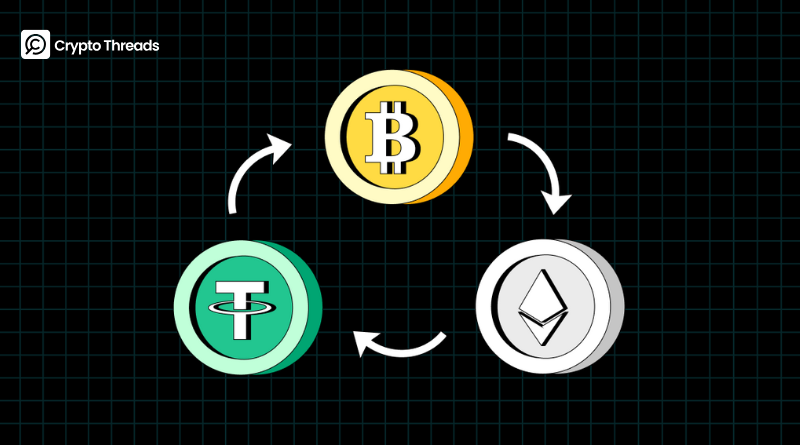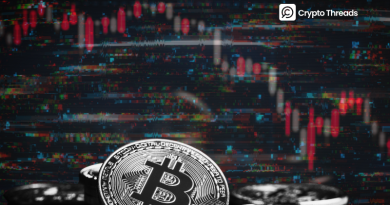Triangular Arbitrage in Forex and Crypto Explained
WHAT IS TRIANGULAR ARBITRAGE?
Triangular arbitrage is a trading strategy in the foreign exchange (forex) and cryptocurrency markets, exploiting inconsistencies in exchange rates between three different currency pairs. It involves trading one currency for a second one, then from the second into the third, and converting back to the original currency with the hope of making profits from the price differences.

In traditional forex markets, this typically took place on the interbank market, where a trader might convert USD to EUR, then to GBP, and back to USD, aiming to end up with more USD by capitalizing temporary market inefficiencies. This approach became prominent in the 1970s and 1980s, after the 1971 collapse of the Bretton Woods system, which allowed currencies to float freely, creating pricing gaps. By the 1990s, electronic trading platforms made detecting these discrepancies faster, reducing opportunities.
In the cryptocurrency market, which gained traction post-2009 with Bitcoin’s rise, triangular arbitrage exploits pricing differences between a coin’s value in USDT and BTC or ETH. For example, a trader could buy BTC with USDT, use BTC to buy FLOKI, then sell FLOKI for more USDT, though high-frequency trading bots on decentralized exchanges have since narrowed these windows.
MATH FORMULA FOR TRIANGULAR ARBITRAGE
Since tokens are traded in pairs on exchanges, we can execute this strategy by buying and selling these pairs sequentially.
Demonstration
Before building a math formula, let’s take a real-world example to get yourself familiarized with the process. In the scenario below, we use three pairs: BTC/USDT, FLOKI/BTC, and FLOKI/USDT, with rates quoted as follows:
BTC/USDT: 1 BTC = 120,000 USDT
FLOKI/BTC: 1 FLOKI = 0.00000000098701 BTC (implying 1 BTC = 1/0.00000000098701 ≈ 1,013,405,248 FLOKI)
FLOKI/USDT: 1 FLOKI = 0.00011828 USDT (implying 1 USDT = 1/0.00011828 ≈ 8,453.168 FLOKI)
Scenario: USDT → FLOKI → BTC → USDT
The trader starts with 10,000 USDT and uses the reverse path to check for arbitrage opportunities.
Buy FLOKI with USDT (FLOKI/USDT):
Pair: FLOKI/USDT (buying FLOKI, selling USDT).
Rate: 1 USDT = 8,453.168 FLOKI.
Action: Sell 10,000 USDT to buy FLOKI.
Calculation: 10,000 USDT × 8,453.168 FLOKI/USDT ≈ 84,531,680 FLOKI.
Result: The trader now has 84,531,680 FLOKI.
Buy BTC with FLOKI (FLOKI/BTC):
Pair: FLOKI/BTC (buying BTC, selling FLOKI).
Rate: 1 FLOKI = 0.00000000098701 BTC.
Action: Sell 84,531,680 FLOKI to buy BTC.
Calculation: 84,531,680 FLOKI × 0.00000000098701 BTC/FLOKI ≈ 0.083451 BTC.
Result: The trader now has 0.083451 BTC.
Sell BTC for USDT (BTC/USDT):
Pair: BTC/USDT (selling BTC, buying USDT).
Rate: 1 BTC = 120,000 USDT.
Action: Sell 0.083451 BTC to buy USDT.
Calculation: 0.083451 BTC × 120,000 USDT/BTC ≈ 10,014.12 USDT.
Result: The trader now has 10,014.12 USDT.
Result: The trader starts with 10,000 USDT and ends with 10,014.12 USDT, yielding a profit of 14.12 USDT (before fees). This indicates a small arbitrage opportunity in this direction.
Math formula
Let’s say we convert currency A to B, B to C and C to A with 3 pairs A/B, B/C and C/A.
Let r(A/B) be the exchange rate for pair A/B, representing the number of units of currency B obtained for 1 unit of currency A.
Let r(B/C) be the exchange rate for pair B/C, representing the number of units of currency C obtained for 1 unit of currency B.
Let r(C/A) be the exchange rate for pair C/A, representing the number of units of currency A obtained for 1 unit of currency C.
These rates assume direct conversions without bid-ask spreads for simplicity.
To detect triangular arbitrage, we calculate the result of converting 1 unit of currency A through the cycle A → B → C → A:
Convert A to B: Start with 1 unit of A, yielding r(A/B) units of B.
Convert B to C: With r(A/B) units of B, you get r(A/B) * r(B/C) units of C.
Convert C to A: With $ r(A/B) * r(B/C) units of C, you obtain r(A/B) * r(B/C) * r(C/A) units of A.
The final amount of A after the cycle is: P = r(A/B) * r(B/C) * r(C/A)
When P > 1, it can be an opportunity for triangular arbitrage. Consider fee and slippage, P should be greater than 1.005, depending on the exchange.
Take your time and consider, what if P <1? Is there any opportunity to execute the strategy? Check the answer at the end of this article.
PROBLEMS IN TRIANGULAR ARBITRAGE EXECUTION
1. Market Efficiency and Speed
Due to the development of automated robots, the discrepancies on exchanges now disappear quite quickly. Therefore, high-speed execution is crucial to capitalize before market corrections. Low-latency infrastructure, like co-located servers, and optimized algorithms minimize delays, ensuring rapid data access and trade placement for profitable arbitrage opportunities.
2. Transaction Costs
Transaction costs, including bid-ask spreads, trading fees, and slippage, can erode arbitrage profits. The opportunity must exceed cumulative spreads and fees across all three trades. Low-fee platforms and high liquidity reduce slippage, ensuring costs don’t outweigh gains in fast-paced triangular arbitrage execution.
3. Liquidity
For smooth execution and maximizing profitability in triangular arbitrage, the amount traded should satisfy the minimum traded amount according to the exchange rule (at least), whereas it should not be large enough to affect the orderbook. This requires the high liquidity of the assets. Low liquidity risks partial fills or inability to complete the arbitrage loop and creating losses.
4. Other Considerations
Exchange selection is vital, favoring reliable platforms with necessary currency pairs and robust APIs, ideally within a single exchange to avoid transfer delays. Accurate calculations, accounting for all decimals, confirm profitability. Risk management mitigates market volatility and counterparty risks, while regulatory compliance and tax record-keeping prevent legal issues. Market conditions, like volatility, create opportunities but heighten risks, requiring adaptability.



